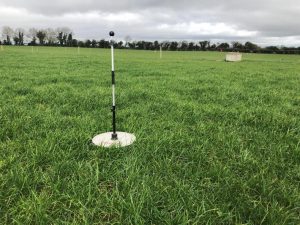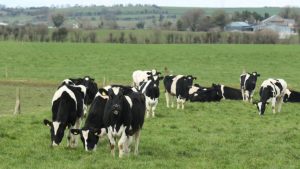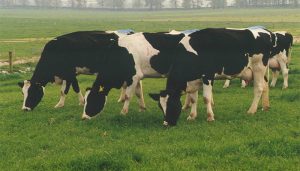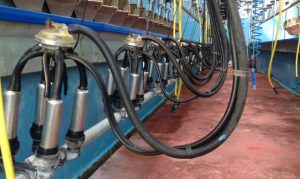
Pat milks just over 100 Holstein-cross Friesian cows on two Lely robots in an all-year-round calving system.
Pat is also involved in his uncle’s suckler farm, where he helps out a number of days every week.
Dairy focus
Originally a sheep farm, it was Pat’s father that changed the enterprise to focus on dairy farming in the 1970s.
After quotas were introduced, the herd continued to expand through purchased and restructured quota.
In 2000, Pat took over the farm and married his now wife, Anna. Pat and Anna now have three children; Ciara, Aoife and Padraic.
The family are milking just over 100 cows on the farm and in November 2020 they invested in Lely robots, with labour being the main reason for this.
Robotic milking
In November 2020, the farm made the switch from a herringbone parlour to robotic milking.
Pat noted that the cows being in the shed helped with the transition to robots and that the challenge really came when the cows went to grass.
He said: “Last year was a big learning experience, but this year it is going really well.
“Last year, with it being the first full year on the robots, the cows were down slightly, but this year they are back up.
“Ourselves and the cows were still getting used to the robots and it took a few weeks to get the cows to come back in to be milked on their own.”

Continuing, Pat said: “The big advantage of the robots is you can identify your best cows and drive them on and you can pick out the passengers fairly quickly.
“We have milk recordings for every milking, so all the figures are there whenever you want them.
“In the old parlour it was a lot harder to pick out the poor cows and you’d be milking more cows with as much milk in the tank.
“A lot of passengers have been moved on in the last few years, which has really improved the herd.
“With the cost of production being so high this year, it’s not the year for having passengers in the herd.”
Breeding
The herd consists of predominately Holstein-cross British Friesian cows, with a 75:25 spilt being what Pat describes as his ideal cow.
Commenting on the breeding focus within this dairy herd, Pat said: “I like a little bit of a mix. I have also aimed bred cows that were 75% Holstein to 25% British Friesian.
“In the last few years we have introduced some Fleckvieh – we have Fleckvieh heifers on the ground – there is nothing in the herd yet but I am looking forward to them.”


Commenting on what Pat is looking for in a cow, he said: “We’re looking for a good ‘milky’ cow, with good feet, good health, that is able to carry herself, which is why we have introduced some Fleckvieh genetics – they have good feet and milk.
“With the robotic system you are really looking for milk in your cows, but you are also looking for cows with good fat and protein, the current herd average is 4.2% fat and 3.5% protein.
“I want a cow producing over 7,500L, anything producing less than that is served to a beef bull.”
Grazing
The cows are on an ABC grazing system, with A and B being fresh grass and C being zero grazed grass.
“The farm here suffers from drought, so the zero-grazer gives you that extra option [and] it also helps with cow throughput in the robots as well,” Pat said.
“When the cows first went to grass we were struggling to get them back in to be milked, but having the grass there helps to bring in the cows and increase the number of milkings in the robot.
“This year they have the choice of zero grazed grass or going out; I think it gives us the best chance to get the most out of them.
“There are some cows that have no interest in going out and if you put them out they’d be back in fairly quick.”

Winter milk
The system on the farm is all-year-round calving and production system, with the farm also having a winter milk contract.
“We have always been winter milking every since my father started milking cows,” said Pat.
“I did look at possibly getting out of it, but my father fought hard to get and keep it. Once we moved into robots the decision was made.”
“It’s a system that’s not working,” said Pat about winter milk. “Liquid milk producers aren’t getting the reward they deserve,” he added.
“We are calving and milking cows in the months with the highest costs and we are not getting financial reward passed back from the processors and supermarkets.
“I don’t think they treat us right or give us the respect we deserve for the work that goes into having fresh milk in supermarkets.
“Unfortunately, it looks like a shortage of fresh milk is going to be needed for everyone to question why farmers aren’t staying at it.”

Pat added: “I enjoy milking over the winter months, particularly in the last number of years, before that I was getting a bit tired of it.
“You’re starting in the dark and finishing in the dark in the pit of the parlour.
“It’s 365 days/year; the first year with the robots was the first time we were able to spend Christmas Day at Anna’s family home.”
Production costs
Input costs are a concern on every farm this year, with Pat stating: “Costs are a major concern this year.
“Yes, milk price has improved greatly and we have never gotten as much for our milk, but the cost of production is way up on previous years – feed, fuel and fertiliser have massively increased this year on farms.
“We are actually using some of the surplus cash this year to purchase fertiliser for next year.
“There is no guarantee that there will be fertiliser there next year, it’s a risk to take but doing nothing is also a risk.”

Continuing, he said: “The higher input costs have taken the focus away from Common Agricultural Policy (CAP) reform which for me, is a big concern.
“It has taken a war to highlight the importance of food security and the importance of protecting food in Europe.
“The CAP is instrumental to secure food supplies in Europe and we are going to need food.
“They are going to bring in food from other parts of world so Europe can be the best-in-class for reducing emissions, but at what cost?”
IFA
Along with being a dairy farmer, Pat is the Irish Farmers’ Association (IFA) regional chair for Connacht.
“I started going to local meetings and I was then proposed at a branch to [hold a position in office],” he explained.
“A couple years later I became secretary of the branch and starting going to the county executives and saw the amount of information that was available.
“If there was an issue affecting you, you could bring it up and hopefully get some help with it.”
Continuing, Pat said: “I was then asked if I would be interested in going for a job in the county executive and from there my involvement increased.
“It was nice to be able to help other farmers that were maybe your friends and neighbours.
“After two or three years, Galway got the chance to put a second delegate on the national council; after an election I was lucky to secure the position. From there I went on to be the county chair and now the regional chair.
“I find I get a real kick out of being able to help someone. When you have a farmer with an issue and you can get in contact with the people that can help, it’s great to be able to do that,” he said.

Commenting on whether he plans to continue within the IFA, Pat said: “I would like to have a crack at going further. I’ve seen the difference that Joe Healy and other IFA presidents were able to make.
“When you’re a regional chair you either move up or move out. I would like to try stay helping people no matter what.”
Future of the farm
Giving some insight into the future of the farm, Pat said: “Padraic is doing the leaving certificate this year and is planning on heading to Pallaskenry Agricultural college.
“I am glad to see he has the interest in farming, but I will be encouraging him to go travelling while he can and get the opportunity that I never got.
“It’s not all about farming, you’ve one life so you have make the most of it.”


























